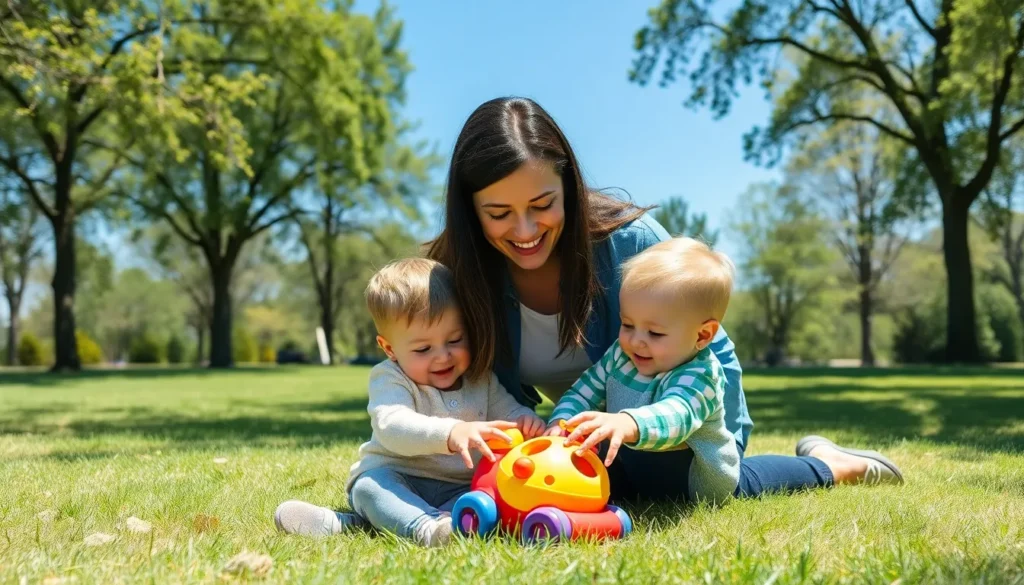Table of Contents
ToggleNavigating the toddler years can feel like trying to herd cats on roller skates. One minute, they’re sweetly giggling, and the next, they’ve transformed into tiny tornadoes of chaos. Every parent knows these little bundles of energy come with their own set of challenges—and a knack for turning the simplest tasks into epic adventures.
Understanding Toddlers’ Development
Understanding the developmental stages of toddlers aids in navigating their behavior. Parents can better support their children by recognizing physical and emotional growth patterns.
Physical Milestones
Physical milestones play a crucial role in toddler development. Around 12 to 18 months, toddlers start walking independently. By age two, many can run, climb, and jump with increasing confidence. Coordination improves significantly as they engage in simple activities like throwing or kicking balls. Fine motor skills develop as toddlers grasp small objects, stack blocks, or use crayons. Tracking these milestones assists parents in recognizing typical progress or identifying potential delays, enabling timely intervention or support.
Emotional Growth
Emotional growth signifies a vital part of a toddler’s development journey. Toddlers begin to express a wider range of emotions, such as joy, frustration, or sadness. Around the age of two, they start to show signs of empathy, often comforting others in distress. Independence becomes an important theme, as they assert preferences and desires. Tantrums frequently occur when toddlers face obstacles or challenges. Encouraging emotional expression through conversation and validation helps in cultivating emotional intelligence and resilience.
Effective Communication Strategies

Effective communication fosters understanding between parents and toddlers. Utilizing clear strategies enhances interactions and strengthens relationships.
Listening and Responding
Active listening creates a foundation for strong communication. Parents should maintain eye contact while their toddlers speak to show engagement. Acknowledging feelings and thoughts encourages toddlers to express themselves freely. It’s crucial for parents to respond appropriately, validating emotions and encouraging dialogue. Phrases such as “I understand you’re upset” confirm that parents are attentive. Reflecting back what toddlers say ensures they feel heard. This practice builds trust and boosts toddlers’ confidence in sharing their thoughts and feelings.
Encouraging Expression
Encouraging expression nurtures toddlers’ emotional development. Parents can prompt conversations by asking open-ended questions, such as “What did you do today?” These questions invite toddlers to elaborate on their experiences. Incorporating storytelling enhances creativity while engaging toddlers in language use. Parents can also provide opportunities for art or play therapy, facilitating non-verbal emotional expression. Celebrating achievements, no matter how small, boosts toddlers’ confidence in expressing themselves. Recognizing their efforts reinforces a positive feedback loop, promoting a healthy emotional and communicative environment.
Creating a Safe Environment
Creating a safe environment supports toddlers’ exploration and development. Implementing safety measures prevents accidents and allows for worry-free play.
Childproofing Your Home
Childproofing involves identifying and removing potential hazards. Start by securing furniture, such as bookshelves and dressers, to walls to prevent tipping. Use safety gates for stairs and lock away cleaning supplies. Keep sharp objects, such as knives and scissors, out of reach. Cover electrical outlets with safety plugs and choose non-toxic materials for toys. Establishing these precautions can lower the risk of injury and foster a secure atmosphere for children to thrive.
Safe Play Areas
Designate specific areas for play, which provides a secure space for toddlers. Select soft flooring, like foam mats or carpets, to cushion falls. Position age-appropriate toys within reach to encourage exploration while minimizing hazards. Fences or gates can define boundaries for outdoor play areas. Supervise playtime consistently, ensuring it remains safe and engaging. Allocating safe play areas offers children the freedom to discover without excessive risk, promoting confidence as they learn.
Discipline Techniques
Effective discipline techniques for toddlers encourage positive behavior while promoting a secure environment. Understanding and implementing useful strategies can greatly improve interactions.
Positive Reinforcement
Positive reinforcement promotes desired behaviors in toddlers effectively. Rewarding toddlers with praise or small incentives strengthens the connection between their actions and positive outcomes. For example, when a child shares a toy, and a parent acknowledges their behavior with enthusiastic praise, the child is more likely to repeat it. Using tangible rewards like stickers or extra playtime also works well, as it provides immediate feedback. Consistency plays a crucial role; parents should reinforce the same behaviors every time to establish a clear pattern.
Setting Boundaries
Setting boundaries helps toddlers understand acceptable behavior. Clear and consistent rules provide a framework for expectations. For instance, designating specific areas for play and setting limits on screen time lays the groundwork for routines. Communicating these boundaries simply ensures toddlers grasp the reasons behind them. When a child crosses a boundary, calmly reminding them of the rules fosters understanding rather than frustration. Establishing consequences for breaking rules reinforces the seriousness of boundaries. Effective boundary-setting nurtures a sense of security, as children feel safe knowing their limits and what to expect.
Engaging Activities for Learning
Engaging activities provide valuable opportunities for toddlers to learn through play. Tailored activities foster cognitive, emotional, and physical growth.
Educational Playtime
Educational playtime encompasses interactive games that enhance learning. Puzzles develop problem-solving skills, while shape sorters introduce basic geometry concepts. Board games encourage turn-taking, teaching patience and social skills. Reading together enhances vocabulary and language comprehension, leaving a lasting impact on literacy development. Parents can use everyday situations to teach concepts—counting apples during snack time reinforces numbers naturally. Encouraging toddlers to explore numbers through fun activities builds a solid foundation for future learning.
Creative Outlets
Creative outlets stimulate imagination and self-expression. Art projects using crayons or finger paints allow toddlers to experiment with colors and textures. Music sessions enable children to explore rhythm and sound, fostering auditory development. Construction toys like blocks inspire spatial awareness and coordination. Storytelling helps toddlers articulate thoughts and feelings, enhancing verbal skills. Nature walks grant opportunities for hands-on experiences, allowing exploration of the environment. Engaging in diverse creative activities nurtures a well-rounded developmental experience.
Navigating the toddler years is a unique journey filled with challenges and rewards. By understanding developmental milestones and fostering emotional growth parents can create a nurturing environment that encourages exploration and learning. Effective communication techniques and consistent discipline strategies play a crucial role in shaping toddlers’ behavior and emotional intelligence.
Incorporating engaging activities into daily routines not only enhances cognitive skills but also nurtures creativity and self-expression. With patience and dedication parents can turn the chaos of toddlerhood into meaningful moments that lay the foundation for their child’s future. Embracing this phase with love and understanding will ultimately lead to a strong bond and a confident little explorer ready to take on the world.







